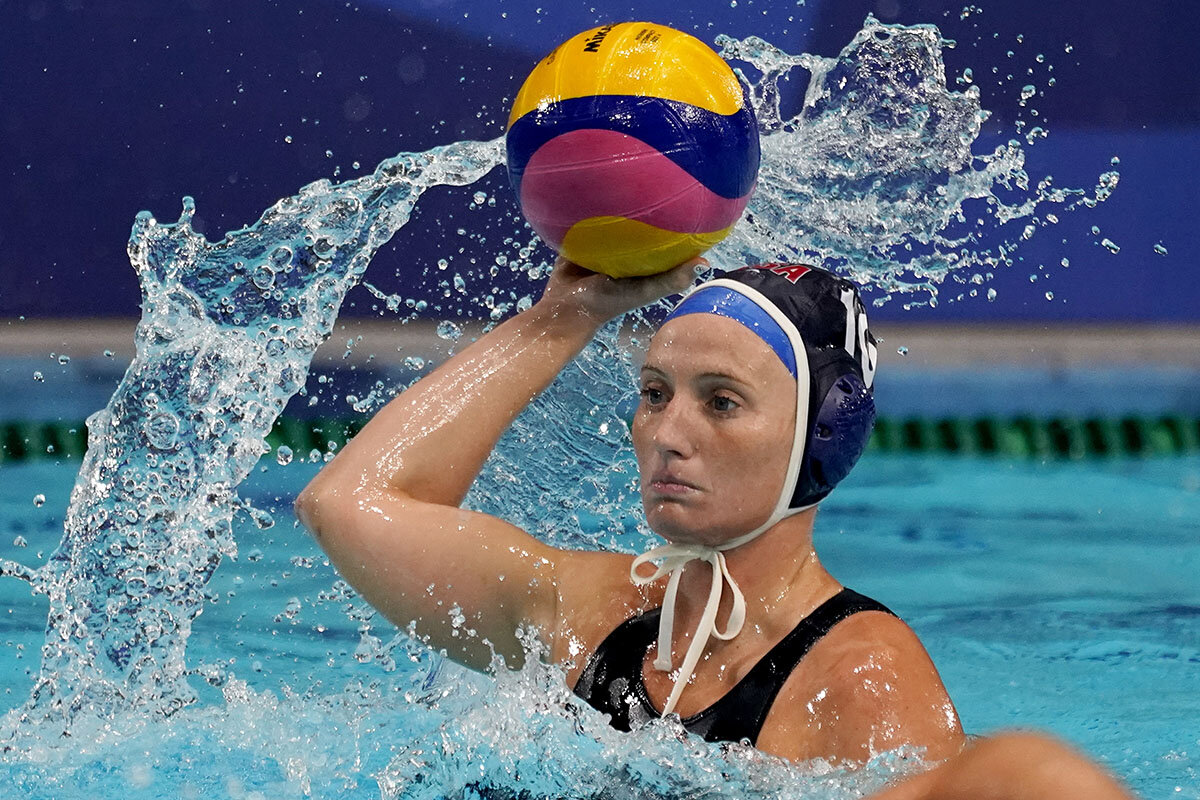Why a yearlong wait is a boon for US water polo
Loading...
| Tokyo
Lurking near the back post during the July 24 U.S. women’s water polo opener, Kaleigh Gilchrist catches a cross-pool pass with her right arm, and in one motion heaves the ball against the water, skipping past the Japanese goalkeeper into the bottom left of the net.
Eighteen to 4, United States in front – Ms. Gilchrist swims across the pool. Minutes later she returns on the attack, earning a penalty shot that she rebounds in for a second goal.
By the final whistle, the U.S. had won 25-4 – setting Olympic records for the most points scored in both half a game and a full game, until Spain beat South Africa 29-4. The U.S. tally is now the second-most lopsided attack in Olympic women’s water polo history.
Why We Wrote This
The long wait for Tokyo “2020,” as organizers are still calling the Games, piled uncertainty and stress on many athletes. But for others, it opened the door to opportunity.
Had the Olympics taken place on time, Ms. Gilchrist likely wouldn’t have been a part of it.
Two years ago, she was celebrating her team’s recent victory at the world championships in Gwangju, South Korea, when the balcony she was standing on collapsed. Two people standing nearby died, and Ms. Gilchrist ended up in the hospital.
Recovery was a long, arduous road. But when the pandemic postponed the Games, her story became a rallying point for the team. If they had to wait another year, at least Ms. Gilchrist would be there.
For many athletes, the postponed pandemic Games have taken away. But for others, like Ms. Gilchrist, the wait has been a gift. Even for a historically dominant U.S. team, that sense of serendipity has added a source of strength and perseverance.
“I was crying on the way over [to the venue], just feeling all the emotions and really reflecting on this journey,” says Ms. Gilchrist, of the bus ride before the July 24 game. “It’s extra special to be in Tokyo.”
Among team sports, water polo stands out for the especially close coordination it demands of its competitors. Neither speech nor players travel easily in a pool of splashing water.
When the U.S. women play, goalkeeper Ashleigh Johnson narrates positions and the shot clock while the team attacks and defends in sync. On offense, the high-scoring team passes in elaborate shapes, like it’s teaching geometry. Wherever they swim, they swim together.
The sport also stands out for its rigor.
Competing in water polo means sprint-swimming back and forth during eight-minute quarters. Play is aggressive, as the teams jostle for position and hurl the ball toward the goal. Somehow, treading water counts as a break.
After Ms. Gilchrist’s injury, returning to the peak fitness required by her sport – a journey she dubbed her “Mamba mission,” a nod to Kobe Bryant’s nickname and their friendship – took bouts of frustration and uncertainty.
“I wasn’t completely there [when I first returned to the pool],” she says. “There was lack of fitness. There was a little self-doubt. There’s stuff that I wasn’t working on that I knew I had to work on.”
So the team worked on it together.
“I was by Kaleigh’s side a lot of that time,” says teammate Maddie Musselman. “I had an injury a year before that. So the moment that she went through it, I was like, you’re not doing it alone.”
In helping Ms. Gilchrist return to the team, the group found inspiration at a sorely needed time.
Every Olympics is new, says captain Maggie Steffens, but the Tokyo Games have challenged athletes unlike any other. Like Ms. Gilchrist, her team members confronted uncertainty and doubt. Her recovery came to symbolize their collective challenges, and gave them a collective reason to persevere.
“Kaleigh’s somebody that brings ... a lot of light to our team,” says Ms. Steffens, “and with that light she brings a lot of hope.”
The U.S. women are heavily favored, but a gold medal isn’t inevitable. The team’s closer 12-7 win against China on Tuesday showed the competition’s strength, and Hungary defeated them 10-9 in another preliminary round Wednesday. Australia, the only other team to beat the U.S. since 2016, is also at the Games.
With each game, Ms. Gilchrist’s Olympic clock winds down. This will be her second and final Games, and she wants to enjoy them – and win. Her dad swam in Tokyo’s 1964 Olympics for Canada. A gold medal here would deepen that personal connection even more.
But a year of starting from athletic square one and gaining confidence has taught her that isn’t everything.
“I thought I had good perspective [before the incident] and I thought I had a good attitude,” says Ms. Gilchrist. “But it’s just gone a higher notch.”
When the game against Japan ended, she wasn’t thinking about her two goals or Olympic records. She was grateful to be there, and proud. She’ll remember something else about what was likely her seventh-last Olympic match.
“It was fun,” she says.








